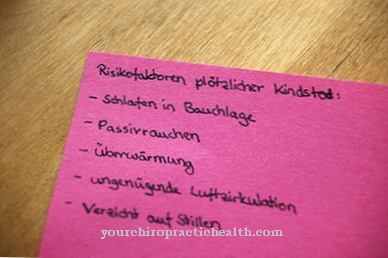The Crimean Congo fever is triggered by viruses. The routes of infection are from animal to person or from person to person. The disease has numerous symptoms that affect the entire organism and range from harmless flu-like symptoms to serious complications. There is currently no vaccination against the disease; therapy with ribavirin is possible.
What is Crimean Congo fever?

© christophstoeckl - stock.adobe.com
The Crimean Congo fever, or Crimean hemorrhagic fever, sometimes abbreviated as CCHF (Crimean-Congo Haemorrhagic Fever), is a virus-induced disease. It occurs mainly in south-east Europe (including Bulgaria, Hungary, Romania, Ukraine and Turkey), in the Middle East (in Syria, Iraq, Iran, Afghanistan) and in numerous countries in Africa and Asia.
The mortality rate is 2 to 50% and is mainly dependent on the virus strain. If there is a death due to the Crimean-Congo fever, it will occur in the second week of illness. Death occurs from the failure of several organs. The disease-causing virus was first isolated from human blood in 1956 in what is now the Republic of the Congo.
At the same time, cases of illness were documented on the Crimean peninsula in Ukraine. Because of this, the disease was given the name Crimean-Congo fever. When several people died of Crimean-Congo fever in the Black Sea region of Turkey in 2006, the disease was brought up again.
causes
The Crimean Congo Fever Virus belongs to the bunyavirus family. The pathogens are present in grass-eating domestic and wild animals such as cows, rabbits, goats and sheep.
The disease is primarily transmitted by the Hyalomma ticks. Over 30 species of the tick have already been identified as the vector. The Hyalomma ticks live in warm regions south of the Balkans. They are characterized by their white and brown banded legs. The disease is not only transmitted from animals to humans through tick bites, but also through direct contact with the flesh or blood of the infected animal.
The virus is transmitted among people by smear infection (through infected body secretions such as urine, saliva, blood or stool), but a droplet infection cannot be ruled out either.
Symptoms, ailments & signs
The Crimean-Congo fever initially has no clear symptoms.After an incubation period of one day up to two weeks, the first symptoms appear. Those affected feel sick and tired at first, typical are flu-like symptoms that quickly increase in intensity.
In addition to fever and chills, there are muscle and limb pain, headache, upper abdominal pain and gastrointestinal complaints. Many patients suffer from nausea and vomiting, but also diarrhea and vomiting blood. It can also cause irritability, mood swings, and depression.
Outwardly, the Crimean-Congo fever can be noticed by the characteristic reddening of the face. This occurs after three to five days and can spread to the conjunctiva and the throat. Sometimes skin bleeding or swelling occurs. The clearest sign is the puncture or bite site that occurs when infected by animals and swells and becomes inflamed as the disease progresses.
The symptoms increase in intensity in the first few days before they slowly subside after one to two weeks. Provided medical treatment is provided, the fever does not cause serious complications. If there is no therapy, the disease can cause serious symptoms and ultimately lead to the death of the person concerned.
Diagnosis & course
Symptoms of the disease appear suddenly after an incubation period of one to 13 days. The incubation time depends on the transmission route. Infection from a tick bite causes symptoms slightly faster than a person-to-person infection. The disease can have many signs.
In addition to general, flu-like symptoms, neurological, gastrointestinal and ophthalmic symptoms occur. The first symptom is a fever, which lasts for 5 to 12 days. In addition to the fever, chills, irritability, enlarged lymph nodes, muscle and limb pain, upper abdominal pain, headache, depression, mood swings, nausea and vomiting can be observed.
Symptoms typical for the disease are facial edema, facial, throat and conjunctival reddening. Some of the sick suffer from complications in the form of a hemorrhagic course from the 3rd to 5th day. This leads to intestinal bleeding, vomiting of blood and skin bleeding. The bleeding tendency increases in the affected patients. In a few cases the Crimean-Congo fever is inapparent, i.e. symptom-free.
Since the disease is caused by viruses, diagnosis is made in laboratory facilities. The antibodies against the virus can be detected from the 6th day of the disease. Up to this point, the symptoms can get worse, depending on the route of infection and the type of virus.
Complications
The Crimean-Congo fever must definitely be examined and treated by a doctor. Without treatment, this disease can lead to death. They suffer from the usual symptoms and symptoms of the flu. The result is a severe fever and continued fatigue. It is not uncommon for patients to suffer from chills and irritability.
Abdominal pain and headache occur, which significantly reduce the quality of life of the person concerned. Reddening of the face can also occur. It is not uncommon for skin bleeding or bloody vomiting to occur, which is often associated with panic attacks or sweating. There is also a reduced resilience of the patient and those affected complain of mood swings or depression. Bleeding in the intestines is not uncommon.
As a rule, Crimean-Congo fever can be treated relatively well with the help of medication. There are no particular complications. With early treatment, most of the symptoms can be limited, so that the disease progresses positively. The life expectancy of the patient is not reduced either.
When should you go to the doctor?
Since the Crimean-Congo fever has a high mortality rate, a doctor should be seen as soon as possible as soon as various health problems become apparent. They include fever, nausea, and vomiting. A doctor should be consulted in the event of headaches, body aches or any other diffuse pain experience. Cramps, restrictions in the musculoskeletal system or disorders of concentration and attention should be examined and treated.
Those affected suffer from muscular complaints, various functional disorders and digestive problems. If you vomit blood, the condition is worrying. A doctor's visit is necessary immediately. Signs such as chills, general malaise and discoloration of the facial skin are also noticeable. If the person concerned suffers from a drop in the usual level of performance, sleep disorders or abnormal heart rhythm, a doctor should be consulted. Crimean-Congo fever occurs primarily in people who are in Asia, the Middle East, South-East Europe or Africa. Therefore, residents or visitors to these regions in particular should consult a doctor if they suffer from the irregularities described.
If existing symptoms increase in scope and intensity or if new symptoms develop, a doctor should be consulted. If individual functional systems of the organism fail, an ambulance service is required. In the event of a circulatory collapse or loss of consciousness, there is an urgent need for action. Since there is danger to life, those present must take first aid measures and call an emergency doctor.
Treatment & Therapy
Treatment is primarily aimed at ensuring that vital functions are secured. During the risk of infection, the infected patients are cared for in an isolation ward. So far there is no vaccination against that Crimean Congo feverbut therapy is possible. This is done with ribavirin, a nucleoside analogue that can fight DNA and RNA viruses. The effectiveness of ribavirin cannot yet be conclusively assessed.
Outlook & forecast
As with many diseases that tend to occur in the Third World, the prognosis for Crimean-Congo fever also depends heavily on the quality of medical care. The Crimean-Congo Hemorrhagic Fever (CCHF), which has previously occurred regionally, is transmitted by ticks.
Often a milder course of the disease leads to a good prognosis. In this case, patients have few symptoms. But the Crimean-Congo fever can also be severe or even fatal. So far, Germany has not been affected by the Crimean-Congo fever. However, other European countries such as Greece, Turkey, Albania, Bulgaria or Serbia have already had a small number of victims to report. As a result, some deaths from this fever have already made the European press.
If medical care ensures proper treatment of Crimean-Congo fever, the prognosis is quite good. However, it is problematic that the Crimean-Congo fever is sometimes confused with other tick-related diseases in areas with a poor infrastructure. It is precarious if the Crimean-Congo fever is confused with early summer meningoencephalitis (TBE) or borreliosis. With such a misdiagnosis, the infection is usually treated incorrectly or too late. This worsens the prognosis, especially if the Crimean-Congo fever is severe. So far there is no protective vaccination against the hemorrhagic Crimean-Congo fever. However, tick protection is possible.
prevention
The first and most important preventive measure is protection against ticks. This is done by wearing closed, light-colored clothing and using deterrents. These protective measures must always be observed, especially when staying in countries where the occurrence of Hyalomma ticks has been proven. In any case, it is recommended to search the whole body for ticks and remove the ticks if necessary.
Aftercare
In most cases of Crimean-Congo fever, follow-up measures are severely limited. The disease must first and foremost be recognized early by a doctor so that there are no further complications or further complaints. An early diagnosis has a positive effect on the further course and can also prevent the symptoms from worsening.
The person concerned should therefore consult a doctor at the first signs and symptoms of Crimean-Congo fever. After an infection, contact with other people should be avoided in any case so that there is no infection. The disease itself is usually treated with medication.
It is always important to ensure that the dosage is correct and that it is taken regularly in order to permanently alleviate the symptoms. If anything is unclear or if you have any questions, a doctor should always be consulted first. With this disease, the person affected should definitely rest and take care of his body. You should refrain from strenuous or stressful activities. If the Crimean-Congo fever is not treated in a timely manner or is insufficiently treated, it can lead to a reduced life expectancy for the person affected.
You can do that yourself
If the Crimean-Congo fever is suspected, the person concerned should immediately go to the nearest hospital. Because of the risk of infection, infected patients must be treated in an isolation ward.
After the acute phase of illness has been overcome, similar measures apply as for other infectious diseases. The affected person needs bed rest in order to survive the after-effects of the illness. He should also drink plenty of fluids and follow a gentle diet. Water and tea as well as chicken broth and rusks have proven themselves. A suitable home remedy is a tea infusion made from elderflower, yarrow and linden blossom, because these medicinal plants support the immune system and make the body sweat. In consultation with the doctor, calf wraps can be used. Homeopathic remedies such as belladonna or aconite also help against the typical fever symptoms.
If the Crimean-Congo fever has not completely subsided after a week, the doctor must be informed. There may be a serious complication that cannot be treated by the individual. If you are depressed, a long conversation with friends or a walk in the fresh air can help. If in doubt, a therapist should be consulted.


.jpg)
.jpg)
.jpg)




















.jpg)


